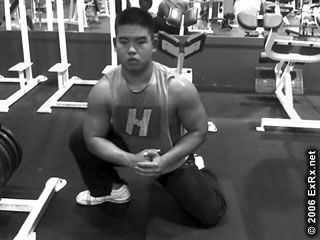Kind of a sloppy practice for me last night. More mentally sloppy than physically sloppy, I suppose. I rolled with very different people during free sparring: Angela, Clint, Chris the Purple, the Mario who is a very new white belt ... a number of very different approaches for me.
I worked some Bravo half guard, the pendulum/Rodrigo's cradle sweep and tbe PTMU count was okay (I think I did it twice). Afterwards I did some specific work with Chris trying to pass his open guard. I forgot to work Saulo's open guard pass, but did get to work on controling the knees and trying to lower the shoulder.
Rodrigo taught Wednesday night's class. Jesse led the warm-up (which was refreshingly devoid of running) and Rodrigo had us doing some takedown pivots with partners that was a pretty nice variation on Mamazinho's throws drill.
Rodrigo had us working on butterfly guard passes. From Mike, it seemed like they'd worked on this Tuesday night, also, because he was able to point out some things I was doing wrong fairly quickly. I started out working with Stephan, which is a lot like getting a mini-private in the middle of a regular class. The first pass was effective for when the guy sits up and manages to get the double underhook.

What you are going to do is reach over his shoulder as deep as you can and grab the middle back. You probably won't be able to reach the belt, but you definitely don't want to just reach your hand behind the guy's head because that will leave you vulnerable to a quick armbar. At the same time, you want to reach under his ankles with the other hand and grab the opposite pants by the ankle. So one hand/arm over and one hand/arm under.
The next step is the spin. This was a point that Stephan emphasized when I was drilling with him. What you want to do is pull with both arms, pulling his back toward you and his foot out to the side. As you do this, you want to backstep toward the side where you've got the over-the-shoulder grab. As you do the backstep, you want to make sure that you lower your shoulder into the guy to keep the pressure on him.
That one I did relatively well. The next one was much trickier for me. It was really a variation on the first one. If I'm remembering right, then what you do is instead of grabbing the opposite pant leg at the ankle, you post out with that same hand/arm. Then you spin on your over-the-shoulder grab side knee as you backstep over the hook on the other side. I was doing this one with Mike and having a hard time with his length. Rodrigo said that you can raise the knee to push into the guy's knee or keep it flat, depending on how long the guy's legs are. It seems to me that whatever you can do to clear the leg with that knee is what you should do. If you can just block it without raising your knee off the mat when you backstep around, great. But if you are smaller, then it seems like you'll almost have to lift the knee up. We'll see.

The other move was easier. It was a slow, methodical, step-by-step pass. You want to flatten the bottom guy out, so that he can't sit up in the butterfly guard as he should. Get tight against him so that his hooks are pressed against his butt. This is the worst position for a guy in the butterfly guard to be in. Lie down against his torso with your elbows in tight.
What you want to do is wait for him to move. Rodrigo says that you can sit there for four minutes if you have to--don't worry about being called for stalling because if you do it right, then you'll get the pass, the points and the dominant position. Once you get some movement from him, you want to kick back one leg and replace it so that you are trapping one hook (one knee, in effect). Again, keep those hooks pinned.
From here, lift your outside leg up and over the one hook/knee. This puts you into half guard. From there, work your half guard pass.
Rodrigo considered these two as pair passes. Try the the second pass, the slow one. If the guy anticipates your move and is able to keep the hook by extending his leg, then switch to the first pass by backstepping with your other leg. You might even be able to reach under and catch the pants by the ankle since his leg is extended. You can do it with or without the spin.
We drilled this in specific. One mistake I was making from the guard position is in getting my hips too close to the guy. In a sense, I was crowding my own legs, making it harder for me to the leverage to move the guy effectively. It's also easier to get your head under his head if your hips are back.
Also, one thing that Chris did well against me was pushing my head to one side to block my pass. It's a good way to fight off the pass if you get your back pushed to the mat. I'd imagine one problem about getting flattened comes from having your hips too close.
I also think puting a foot on the hip to push the guy back in order to reset your hips further back is a reasonable move. Ideally, I like the "B.J. Penn guard" where you've got feet on both hips. I think that's a matter of very good hamstring flexibility, but it would make it so easy to transition to butterfly, closed and half-guard that I ought to make hamstring flexibility a priority. I've got a nice little hamstring stretch series, and hamstrings are always one of the easier leg stretches since you can do them standing.
While I'm on the subject of flexibility, though it's not necessary to do a good pendulum sweep, I wouldn't mind having better
hip adductor (groin) flexibility, either.

In terms of passing the guard, I didn't do too badly, even if there was more "hopping" than "stepping" much of the time. I'm clearly more comfortable with the slow pass than the backstep pass. The spin version of the latter is working better for me than the one that relies on the knee pivot.


















